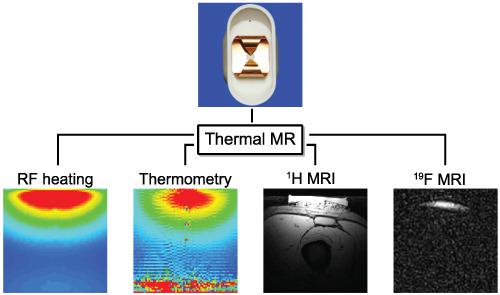当前位置:
X-MOL 学术
›
NMR Biomed.
›
论文详情
Our official English website, www.x-mol.net, welcomes your
feedback! (Note: you will need to create a separate account there.)
Wideband Self-Grounded Bow-Tie Antenna for Thermal MR.
NMR in Biomedicine ( IF 2.7 ) Pub Date : 2020-02-20 , DOI: 10.1002/nbm.4274 Thomas Wilhelm Eigentler 1, 2 , Lukas Winter 1, 3 , Haopeng Han 1, 4 , Eva Oberacker 1 , Andre Kuehne 5 , Helmar Waiczies 5 , Sebastian Schmitter 3 , Laura Boehmert 1, 6 , Christian Prinz 1, 6 , Hana Dobsicek Trefna 7 , Thoralf Niendorf 1, 5, 8
NMR in Biomedicine ( IF 2.7 ) Pub Date : 2020-02-20 , DOI: 10.1002/nbm.4274 Thomas Wilhelm Eigentler 1, 2 , Lukas Winter 1, 3 , Haopeng Han 1, 4 , Eva Oberacker 1 , Andre Kuehne 5 , Helmar Waiczies 5 , Sebastian Schmitter 3 , Laura Boehmert 1, 6 , Christian Prinz 1, 6 , Hana Dobsicek Trefna 7 , Thoralf Niendorf 1, 5, 8
Affiliation

|
The objective of this study was the design, implementation, evaluation and application of a compact wideband self-grounded bow-tie (SGBT) radiofrequency (RF) antenna building block that supports anatomical proton (1 H) MRI, fluorine (19 F) MRI, MR thermometry and broadband thermal intervention integrated in a whole-body 7.0 T system. Design considerations and optimizations were conducted with numerical electromagnetic field (EMF) simulations to facilitate a broadband thermal intervention frequency of the RF antenna building block. RF transmission (B1 + ) field efficiency and specific absorption rate (SAR) were obtained in a phantom, and the thigh of human voxel models (Ella, Duke) for 1 H and 19 F MRI at 7.0 T. B1 + efficiency simulations were validated with actual flip-angle imaging measurements. The feasibility of thermal intervention was examined by temperature simulations (f = 300, 400 and 500 MHz) in a phantom. The RF heating intervention (Pin = 100 W, t = 120 seconds) was validated experimentally using the proton resonance shift method and fiberoptic probes for temperature monitoring. The applicability of the SGBT RF antenna building block for in vivo 1 H and 19 F MRI was demonstrated for the thigh and forearm of a healthy volunteer. The SGBT RF antenna building block facilitated 19 F and 1 H MRI at 7.0 T as well as broadband thermal intervention (234-561 MHz). For the thigh of the human voxel models, a B1 + efficiency ≥11.8 μT/√kW was achieved at a depth of 50 mm. Temperature simulations and heating experiments in a phantom demonstrated a temperature increase ΔT >7 K at a depth of 10 mm. The compact SGBT antenna building block provides technology for the design of integrated high-density RF applicators and for the study of the role of temperature in (patho-) physiological processes by adding a thermal intervention dimension to an MRI device (Thermal MR).
中文翻译:

适用于热MR的宽带自接地蝶形天线。
这项研究的目的是设计,实施,评估和应用紧凑的宽带自接地领结(SGBT)射频(RF)天线构建模块,该模块可支持解剖质子(1 H)MRI,氟(19 F)MRI ,MR测温和宽带热干预集成在整个7.0 T系统中。使用数字电磁场(EMF)模拟进行设计考虑和优化,以促进RF天线构件的宽带热干预频率。在幻像中获得了RF传输(B1 +)场效率和比吸收率(SAR),并在7.0 T处进行了1 H和19 F MRI的人体素模型(Ella,Duke)的大腿。验证了B1 +效率模拟实际的倒角成像测量。通过体模中的温度模拟(f = 300、400和500 MHz)检查了热干预的可行性。RF加热干预(Pin = 100 W,t = 120秒)已通过质子共振位移法和用于温度监测的光纤探头进行了实验验证。证实了SGBT RF天线构件在体内1 H和19 F MRI中的适用性,适用于健康志愿者的大腿和前臂。SGBT RF天线构件促进了7.0 T时的19 F和1 H MRI以及宽带热干预(234-561 MHz)。对于人类体素模型的大腿,在50 mm的深度处实现了B1 +效率≥11.8μT/√kW。人体模型中的温度模拟和加热实验表明,在10毫米深度处,温度升高ΔT> 7K。
更新日期:2020-02-20
中文翻译:

适用于热MR的宽带自接地蝶形天线。
这项研究的目的是设计,实施,评估和应用紧凑的宽带自接地领结(SGBT)射频(RF)天线构建模块,该模块可支持解剖质子(1 H)MRI,氟(19 F)MRI ,MR测温和宽带热干预集成在整个7.0 T系统中。使用数字电磁场(EMF)模拟进行设计考虑和优化,以促进RF天线构件的宽带热干预频率。在幻像中获得了RF传输(B1 +)场效率和比吸收率(SAR),并在7.0 T处进行了1 H和19 F MRI的人体素模型(Ella,Duke)的大腿。验证了B1 +效率模拟实际的倒角成像测量。通过体模中的温度模拟(f = 300、400和500 MHz)检查了热干预的可行性。RF加热干预(Pin = 100 W,t = 120秒)已通过质子共振位移法和用于温度监测的光纤探头进行了实验验证。证实了SGBT RF天线构件在体内1 H和19 F MRI中的适用性,适用于健康志愿者的大腿和前臂。SGBT RF天线构件促进了7.0 T时的19 F和1 H MRI以及宽带热干预(234-561 MHz)。对于人类体素模型的大腿,在50 mm的深度处实现了B1 +效率≥11.8μT/√kW。人体模型中的温度模拟和加热实验表明,在10毫米深度处,温度升高ΔT> 7K。










































 京公网安备 11010802027423号
京公网安备 11010802027423号